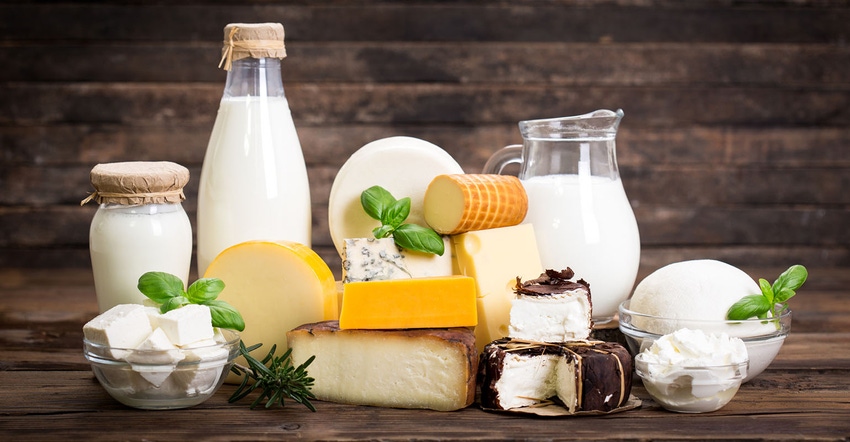
Those who follow the dairy complex recognize the volatility that zigs and zags price action on a frequent basis. Class III milk futures price movement had been mostly quiet early this year as the food box program from the Trump administration came to a close. That program spurred domestic demand for dairy products, which allowed for $24.00 milk prices during 2020.
In the early months of 2021, without that extra domestic demand from the food box program, milk prices sank to near $15.00 and $16.00 -- not even breakeven for many dairy farms. The December milk production report showed production up 3%, which severely weighed on prices in early 2021.
However, there may be optimism for milk prices just around the corner.
Milk production
The most recent milk production report was friendlier than many in the industry had anticipated. Milk production across the United States rose just 1.60% in January. A large element of this production decrease from December was the fact that cow numbers were up only 85,000 head from a year ago in January, compared to up 100,000 head year-over-year in December.
State-by-state breakdown
Looking at production out east, the results were variable. Production in Virginia fell 3%, while New York’s production added 0.7%. Pennsylvania was down a mere 0.1%. Out west, California’s production fell 0.7% year-over-year. Midwest production remains strong. Michigan production was up 4.30%, Minnesota added 5.7% to their production totals, and Wisconsin’s production was up 3.1%.
Soy meal rationing?
Living in Wisconsin, I am in the heart of dairy country. In visiting with clients I began to see a growing trend. I have been told that some local dairy farms who are looking to book soybean meal for summer delivery have been turned down. As in, there is concern that soybeans will be tricky to find locally this summer, to then be crushed into soybean meal.
If true, other protein packed feed substitutes will need to be sourced to round out feed rations. The dairy cows around here are fed like lean, mean production champions with only top notch feed ingredients. If nutrients potentially are sacrificed due to lack of availability, it’s possible milk production may fall in the summer months.
Time will tell, but this is definitely something the industry needs to monitor.
Global demand remains strong
This week’s Global Dairy Trade auction had a positive tone to demand. The GDT Price Index jumped 15% with many dairy products benefiting. According to the dairy team at Total Farm Marketing, “Within the event, whole milk powder rallied 21% and moved into a new 5-year high. GDT butter tacked on 13.7% and is within striking distance of a 5-year high. Rounding out the event was GDT cheddar up 1.3% and GDT skim milk powder up 3.5%.” This is welcome news for the dairy complex.
Here at home, there also remains optimism that U.S. Secretary of Agriculture Tom Vilsack will create a new domestic version of a food box program to continue to help the millions of Americans affected by Covid. Things may be looking up again for milk prices.
Reach Naomi Blohm: 800-334-9779 Twitter: @naomiblohm and [email protected]
Disclaimer: The data contained herein is believed to be drawn from reliable sources but cannot be guaranteed. Individuals acting on this information are responsible for their own actions. Commodity trading may not be suitable for all recipients of this report. Futures and options trading involve significant risk of loss and may not be suitable for everyone. Therefore, carefully consider whether such trading is suitable for you in light of your financial condition. No representation is being made that scenario planning, strategy or discipline will guarantee success or profits. Any decisions you may make to buy, sell or hold a futures or options position on such research are entirely your own and not in any way deemed to be endorsed by or attributed to Total Farm Marketing. Total Farm Marketing and TFM refer to Stewart-Peterson Group Inc., Stewart-Peterson Inc., and SP Risk Services LLC. Stewart-Peterson Group Inc. is registered with the Commodity Futures Trading Commission (CFTC) as an introducing broker and is a member of National Futures Association. SP Risk Services, LLC is an insurance agency and an equal opportunity provider. Stewart-Peterson Inc. is a publishing company. A customer may have relationships with all three companies. SP Risk Services LLC and Stewart-Peterson Inc. are wholly owned by Stewart-Peterson Group Inc. unless otherwise noted, services referenced are services of Stewart-Peterson Group Inc. Presented for solicitation.
The opinions of the author are not necessarily those of Farm Futures or Farm Progress.
About the Author(s)
You May Also Like






